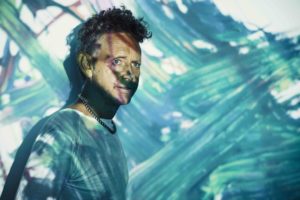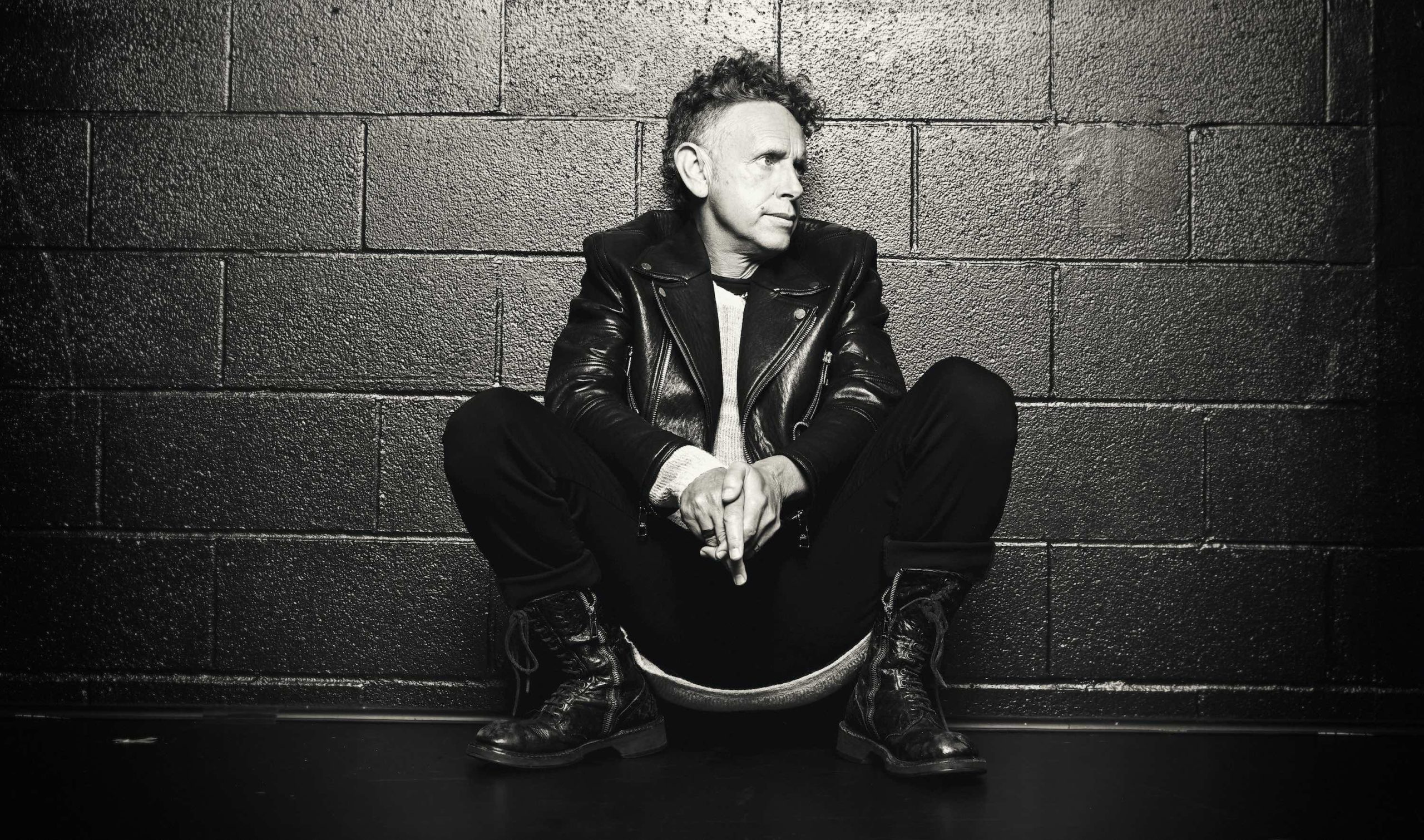It’s been nearly four years since the release of the last Depeche Mode studio album, Spirit, and just under two years since the iconic group’s last live shows—which means the time is ripe for a solo project from principal songwriter, Martin Gore. As your average, garden-variety musical genius, what better use of Gore’s time during a year of lockdown than knocking out an EP? The Third Chimpanzee is a primate-themed record whose five songs are named after different breeds. The EP gets its title from the non-fiction science book The Rise and Fall of the Third Chimpanzee: How Our Animal Heritage Affects the Way We Live. The book explores the shared genetics of humans and two particular species of chimpanzees, delving into the human and animal reasons behind our actions. The EP’s title refers to humans, or “the third chimpanzee.”
Really getting into the theme, Gore—who’ll be turning sixty this year—commissioned Pockets Warhol, the capuchin monkey who is the artist-in-residence at Story Book Farm Primate Sanctuary in Ontario, Canada to create the artwork for the EP. An abstract expressionist work reminiscent of Jackson Pollock’s splatter paintings—only more restrained—Pockets’ masterpiece is a definite collector’s item.
Gore doesn’t tend to release a lot of solo material. Chimpanzee comes half a decade after his sixteen-track LP MG. There was a twelve-year gap between MG and Counterfeit2, his album of covers of songs that have been influential in his songwriting for Depeche Mode. Prior to that was the 1989 six-song Counterfeit EP, also a covers collection. In sharp contrast, The Third Chimpanzee is wholly instrumental. transitioning smoothly from deep lows to bright highs and conveying many emotions in the process.
Speaking to FLOOD from his Electric Ladyboy Studio in his adopted hometown of Santa Barbara, Gore discusses trying to keep up his reading habits, the primate theme of The Third Chimpanzee, and being inducted into the Rock and Roll Hall of Fame.
Considering 2020 fell in between Depeche Mode album cycles, would you have been doing something besides being home and going to the studio?
I’ve been able to adapt to this lifestyle quite easily. I go to the studio most days anyway. I’m looking at this retroactively, but one of the reasons I came up with an instrumental EP is because I didn’t feel particularly inspired to write lyrics. Maybe that’s because we don’t have much stimulation. We don’t move. We don’t go anywhere. We don’t do anything. And maybe that doesn’t create the best circumstances to write lyrics.
The first song from the EP, “Howler,” came before the pandemic. Was that written without lyrics in mind?
That was the first track I wrote, but it was a track that I didn’t have a particular project for. It was just something I had sitting around. After we went into lockdown I thought maybe I should try and be more productive. I don’t have great ideas for lyrics, but I can usually do something instrumentally if I set my mind to it, maybe that’s just what I should start working on.
Even though there aren’t lyrics, there are a lot of emotions packed in over the course of the EP’s 25 minutes, even within each track more than one emotion is explored.
A lot of people have picked up on the fact that it’s quite dark, but something that people haven’t picked up on very much is that, especially “Capuchin,” is like a sci-fi Western. For me, it’s almost got a comical wonky beat to it. Maybe that’s just me. There are the vocal bits that are being synthesized and manipulated, so there is an actual voice on there, but it doesn’t sound human.

Were you drawn toward a particular type of gear for this EP?
I use quite a lot of Eurorack modular stuff, still. For a lot of the manipulation I used a particular module called the Panharmonium. My studio is a crazy mess. There’s just stuff all over the floor. I think it’s the sign of being creative.
That’s not what I imagined at all. What I saw in my head was an image of the future as seen by people in the ’50s with loads of very organized gleaming modular equipment whirring away, and you as a scientist in the middle of it all. You’re ruining my image of you in creation mode.
I’ve literally got a tangle of wires in front of me and boxes on the floor. If it was a pristine, neat place, it probably wouldn’t be a very used studio.
Your concepts seem to emerge while you’re working rather than being pre-planned.
Yeah, the whole thing slowly took shape after “Mandrill,” when I got the idea to record some more vocals like I did on “Howler” and manipulate them and make them sound non-human and a bit more monkey-like. When I started working on “Capuchin,” I carried on that theme again. That’s where the concept of the EP came about. At that point I didn’t have a name for the EP. I didn’t think about getting Pockets Warhol involved to do the artwork.
The name of the EP comes from the book, The Rise and Fall of the Third Chimpanzee. What made you pick that book up?
“One of the reasons I came up with an instrumental EP is because I didn’t feel particularly inspired to write lyrics. Maybe that’s because we don’t have much stimulation. We don’t move. We don’t go anywhere. We don’t do anything. And maybe that doesn’t create the best circumstances to write lyrics.”
I read it when it first came out. One of the sections I used to love browsing through was the science section, and I used to read quite a lot of scientific books. I used to love reading. I still like reading, but not as much as I used to. I’m forcing myself to read more, but it doesn’t come as naturally to me now. I think it’s the digital age. I really don’t like the fact that I get sucked away from books by my iPad and just doing inane things on the internet. I think humankind would be better off if the internet had never been invented.
It does make it difficult to focus.
I only have time to read at night on the last hour of the day. Apart from being in the studio, I have a three- and a four-year-old, and I have to be a dad. It’s usually just before I go to bed at midnight, and then half the time I’m like, “Oh, there’s my iPad.”
It’s not as fun browsing online for a book as it is wandering in a bookstore or library.
It’s the randomness of it, that sometimes you would find something that you would have never been interested in, but you pick it up and you’re like, “That’s interesting.” These days, the algorithms know what we like.
I was only made aware of Pockets Warhol after this EP and I really like what he’s created. What was the process of getting him to do the artwork like?
I reached out to the sanctuary and they got straight back to me and they were interested in having Pockets do the artwork. I was mostly dealing with a woman named Charmaine who calls herself “Pockets’ Muse.” First of all, I asked if he could paint on a 12 x 12, same size as vinyl, canvases. And then we decided some of them should be on black canvas, and some on white canvas. Then she asked me to choose the colors. I love it. I think it looks fantastic. I just saw the vinyl cover the other day and it looks so good.
You’ve put together a playlist on Spotify, “Escaping 2020,” which is very diverse with nothing obvious included. It seems you’re always listening and discovering new things.
I’m always looking for music, new and interesting things. I do a lot of hunting these days on Bandcamp. It’s especially interesting to find artists that are not so well known. One thing I do is look at their recommendations. I listen to everything unless it’s something with “metal” in the title, that I usually skip.
I spoke to your one-time Depeche Mode bandmate Vince Clarke about being inducted into the Rock and Roll Hall of Fame and he wasn’t too excited about it, and felt he belonged more in the “Pop Hall of Fame.” What is your feeling about it?
It’s an honor to have been inducted. I got sucked into music by rock and roll anyway, the original rock and roll through my mother. I feel honored to have been inducted along with all of those people that I used to listen to as a kid. FL








